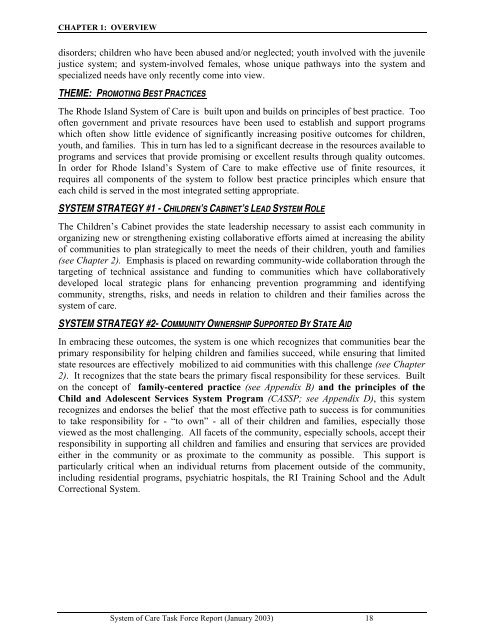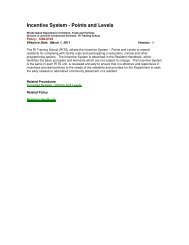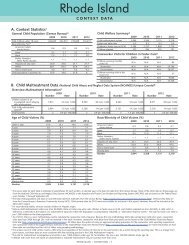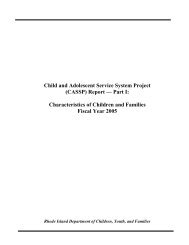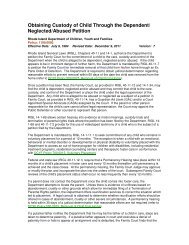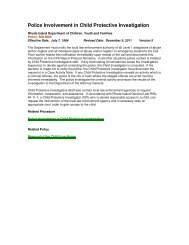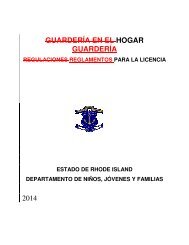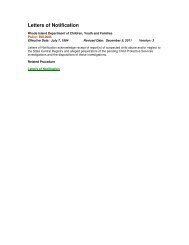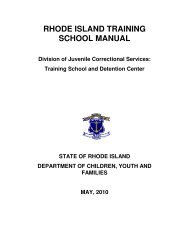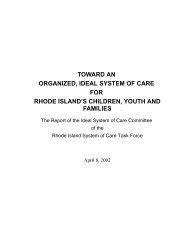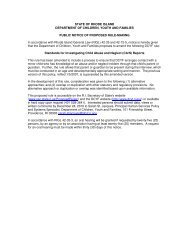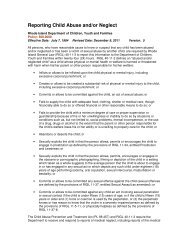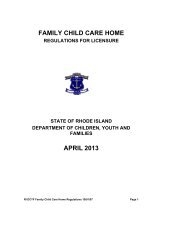Final Report - RI Department of Children, Youth & Families
Final Report - RI Department of Children, Youth & Families
Final Report - RI Department of Children, Youth & Families
Create successful ePaper yourself
Turn your PDF publications into a flip-book with our unique Google optimized e-Paper software.
CHAPTER 1: OVERVIEW<br />
disorders; children who have been abused and/or neglected; youth involved with the juvenile<br />
justice system; and system-involved females, whose unique pathways into the system and<br />
specialized needs have only recently come into view.<br />
THEME: PROMOTING BEST PRACTICES<br />
The Rhode Island System <strong>of</strong> Care is built upon and builds on principles <strong>of</strong> best practice. Too<br />
<strong>of</strong>ten government and private resources have been used to establish and support programs<br />
which <strong>of</strong>ten show little evidence <strong>of</strong> significantly increasing positive outcomes for children,<br />
youth, and families. This in turn has led to a significant decrease in the resources available to<br />
programs and services that provide promising or excellent results through quality outcomes.<br />
In order for Rhode Island’s System <strong>of</strong> Care to make effective use <strong>of</strong> finite resources, it<br />
requires all components <strong>of</strong> the system to follow best practice principles which ensure that<br />
each child is served in the most integrated setting appropriate.<br />
SYSTEM STRATEGY #1 - CHILDREN’S CABINET’S LEAD SYSTEM ROLE<br />
The <strong>Children</strong>’s Cabinet provides the state leadership necessary to assist each community in<br />
organizing new or strengthening existing collaborative efforts aimed at increasing the ability<br />
<strong>of</strong> communities to plan strategically to meet the needs <strong>of</strong> their children, youth and families<br />
(see Chapter 2). Emphasis is placed on rewarding community-wide collaboration through the<br />
targeting <strong>of</strong> technical assistance and funding to communities which have collaboratively<br />
developed local strategic plans for enhancing prevention programming and identifying<br />
community, strengths, risks, and needs in relation to children and their families across the<br />
system <strong>of</strong> care.<br />
SYSTEM STRATEGY #2- COMMUNITY OWNERSHIP SUPPORTED BY STATE AID<br />
In embracing these outcomes, the system is one which recognizes that communities bear the<br />
primary responsibility for helping children and families succeed, while ensuring that limited<br />
state resources are effectively mobilized to aid communities with this challenge (see Chapter<br />
2). It recognizes that the state bears the primary fiscal responsibility for these services. Built<br />
on the concept <strong>of</strong> family-centered practice (see Appendix B) and the principles <strong>of</strong> the<br />
Child and Adolescent Services System Program (CASSP; see Appendix D), this system<br />
recognizes and endorses the belief that the most effective path to success is for communities<br />
to take responsibility for - “to own” - all <strong>of</strong> their children and families, especially those<br />
viewed as the most challenging. All facets <strong>of</strong> the community, especially schools, accept their<br />
responsibility in supporting all children and families and ensuring that services are provided<br />
either in the community or as proximate to the community as possible. This support is<br />
particularly critical when an individual returns from placement outside <strong>of</strong> the community,<br />
including residential programs, psychiatric hospitals, the <strong>RI</strong> Training School and the Adult<br />
Correctional System.<br />
System <strong>of</strong> Care Task Force <strong>Report</strong> (January 2003) 18


